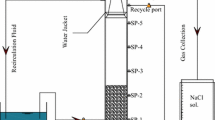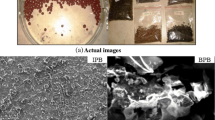Abstract
During the anaerobic biodegradation of effluent from a dimethyl terephthalate (DMT) manufacturing plant, reduction in chemical oxygen demand (COD) degradation and biogas formation was observed after the waste-water concentration exceeded 25% of added feed COD. This condition reverted back to normal after 25–30 days when the DMT waste-water concentration in the feed was brought down to a non-toxic level. However, the above effects were observed only after the concentration of DMT waste-water reached more than 75% of added feed COD when biomass support particles (BSP) were augmented to the system. In the BSP system, a biomass concentration of up to 7000 mg/l was retained and the sludge retention time increased to > 200 days compared to 2200 mg/l and 8–10 days, respectively, in the system without BSP (control). Formaldehyde in the waste-water was found to be responsible for the observed toxicity. The BSP system was found to resist formaldehyde toxicity of up to 375 mg/l as against 125 mg/l in the control system. Moreover, the BSP system recovered from the toxicity much faster (15 days) than the control (25–30 days). The advantages of the BSP system in anaerobic treatment of DMT waste-water are discussed.
Similar content being viewed by others
References
APHA (1985) Standard methods for the examination of water and waste-water, 16th edn. American Public Health Association, Washington, D. C.
ASTM (1985) Standard test method for concentration of formaldehyde solutions. D 2194–79. Annual book of ASTM standards, 6.03: 375–376. American Society for testing and Materials, Washington, D. C.
Bailey BW, Rankin JM (1977) New spectrophotometric method for determination of formaldehyde. Anal Chem 43:782–784
Borup MB, Middlebrooks EJ (1987) Pollution control in the petrochemical industry. Lewis, Chelsea, Mich.
Britz TJ, Meyer LC, Botes PJ (1983) Anaerobic digestion of a petrochemical effluent. Biotechnol Lett 5:113–118
Britz TJ, Noeth C, Lategan PM (1988) Nitrogen and phosphate requirements for the anaerobic digestion of a petrochemical effluent. Water Res 22:163–169
Canovas-Diaz M, Howll JA (1987) Stratified ecology techniques in the startup of an anaerobic downflow fixed film percolating reactor. Biotechnol Bioeng 30:289–296
Chou WL, Speece RE, Siddiqui RH (1978a) Acclimation and degradation of petrochemical waste-water components by methane fermentation. Biotechnol Bioeng Symp 8:391–414
Chow WL, Speece RE, Siddiqui RH, Mckeon K (1987b) The effect of petrochemical structure on methane fermentation toxicity. Prog Water Technol 10:545–558
Dohanyos M, Zabranska J, Grau P (1988) Anaerobic breakdown of acrylic acid. In: Hall ER, Hobson PN (eds) Anaerobic digestion — 1988, Pergamon Press, Oxford, pp 287–294
Fisher JA, Hovious JC, Kumke GW, Conway RA (1971) Pilot demonstration of basic designs for anaerobic treatment of petrochemical wastes. Chem Eng Prog Symp Ser 67:485–496
Guyot JP, Macarie H, Noyola A (1990) anaerobic digestion of a petrochemical waste-water using the UASB process. Appl Biochem Biotechnol 24:579–589
Hovious JC, Conway RA, Ganze CW (1973) Anaerobic lagoon pretreatment of petrochemical wastes. J Water Pollut Control Fed 45:71–76
Nel LH, Britz TJ (1986) The influence of different substrate pH values on the performance of a downflow anaerobic fixed bed reactor treating a petrochemical effluent. Biotechnol Lett 8:293–298
Nel LH, De Haast J, Britz TJ (1984) Anaerobic digestion of a petrochemical effluent using an upflow anaerobic sludge blanket reactor. Biotechnol Lett 6:741–746
Nel LH, Britz TJ, Lategan PM (1985) The effect of trace elements on the performance efficiency of an anaerobic fixed film reactor treating a petrochemical effluent. Water SA 11:107–110
Noyola A, Macarie H, Guyot JP (1990) Treatment of terephthalic acid plant waste-water with an anaerobic fixed film reactor. Environ Technol 11:239–248
Parkin GF, Speece RE (1983) Attached versus suspended growth anaerobic reactors: response to toxic substances. Water Sci Technol 15:261–289
Parkin GF, Speece RE, Yang CHJ, Kocher WM (1983) Response of methane fermentation system to industrial toxicants. J Water Pollut Control Fed 55:44–53
Singh M, kar D (1989) Effect of fluoride on the settleability of biomass from an activated sludge plant treating petrochemical effluent. J Ferment Bioeng 67:366–368
Speece RE (1983) Anaerobic biotechnology for industrial waste-water treatment. Environ Sci Technol 17:416A–427A
Wheatley AD (1990) Anaerobic digestion — industrial waste treatment. In: Wheatley A (ed) Anaerobic digestion: a waste treatment technology. Elsevier, London, pp 171–213
Author information
Authors and Affiliations
Additional information
Correspondence to: C. Ramakrishna
Rights and permissions
About this article
Cite this article
Sharma, S., Ramakrishna, C., Desai, J.D. et al. Anaerobic biodegradation of a petrochemical waste-water using biomass support particles. Appl Microbiol Biotechnol 40, 768–771 (1994). https://doi.org/10.1007/BF00173343
Received:
Accepted:
Issue Date:
DOI: https://doi.org/10.1007/BF00173343




